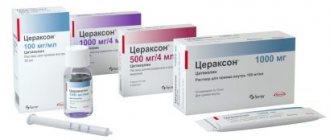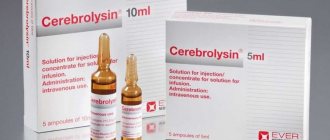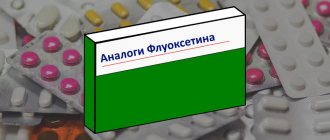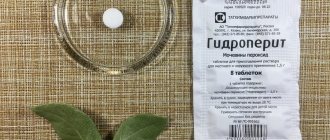Tramadol is a very old opioid painkiller. The pharmaceutical drug is used to eliminate severe pain; to a greater extent, the drug is prescribed to cancer patients. The analgesic effect of Tramadol is 5 times less than that of morphine. The medication is sold as a single drug or in combination with paracetamol.
Group: pharmaceutical drugs
Is Tramadol a drug?
At the initial stage of studying tramadol, it was recognized that pain relief occurs due to the participation of the opioid system, the medication was classified as a narcotic painkiller.
Trambadol
The small number of side effects is explained by the establishment of a mixed mechanism of action. In Russia, the analgesic is included in the group of vital and essential drugs.
Consequently, according to the current classification, Tramadol is not considered a narcotic substance, but is classified as a potent drug. The medication is not dispensed without a prescription from the attending physician.
Use in doses exceeding the therapeutic range contributes to the formation of dependence.
Instructions for use
As mentioned above, Tramadol is sold in pharmacies only with a doctor's prescription. The prescription is written out on form 148-1/у-88.
Rp.: Tab. Tramadoli 0.1 DtsN 30 S. 1 tablet. * 2 w.d.
In tablets
The tablets are taken orally, without chewing, swallowing whole. It is important to take the medicine with enough water.
The medicine is used exclusively as prescribed by the doctor, the dosage is selected individually for each patient, it all depends on the severity of the pain. Recommended dosages are only indicative; the duration of treatment with tablets is determined by the doctor personally for each patient. When treating chronic pain, an analgesic dosage schedule should be followed.
You should not take more than 8 tablets with a dosage of 50 mg or 4 tablets with a dosage of 100 mg per day (exceptions: postoperative pain, oncology).
A single dose for persons over 14 years of age (weight over 25 kg) is equal to 1 tablet with a dosage of 50 mg or half a tablet with a dosage of 100 mg. If the pain does not go away, you can take 1 more tablet after an hour.
For severe pain, a single dose may be 100 mg.
In persons over 75 years of age, in patients with renal or liver failure, Tramadol is eliminated from the body more slowly. It may be advisable to increase the time between new doses.
In ampoules
Solution for injection 50 mg/ml and 100 mg/2 ml.
The doctor selects the dosage of the drug individually for each patient.
For persons over 14 years of age, the drug is administered slowly by drip, 1 ml-2 ml of solution (50-100 mg), 400 mg is the permissible dosage per day. When administered subcutaneously or intramuscularly, the drug is taken in the same dosage. A repeat drip can be placed only after 4 hours.
The recommended dosage per day should not exceed 400 mg, but in severe cases, doctors take the liberty of increasing the dosage to 600 mg.
For patients with kidney or liver failure, doctors may prescribe a lower dosage of pain medication.
Video on the topic:
Tramadol
Tramadol is used as prescribed by a doctor; the dosage regimen of the drug is selected individually depending on the severity of the pain syndrome and the sensitivity of the patient. The duration of treatment is determined individually; the drug should not be prescribed beyond the period justified from a therapeutic point of view.
Tramadol is intended for intravenous (administer slowly), intramuscular, or subcutaneous administration. Unless otherwise prescribed, Tramadol should be prescribed in the following dosages.
For adults and teenagers over 14 years old
for a single administration of 50-100 mg of tramadol hydrochloride (1-2 ml of solution for injection). If satisfactory analgesia does not occur, a repeat single dose of 50 mg (1 ml) may be prescribed after 30-60 minutes. For severe pain, a higher dose (100 mg tramadol hydrochloride) may be prescribed as an initial dose. In general, 400 mg of tramadol hydrochloride/day is usually sufficient to relieve pain.
For the treatment of pain due to cancer and severe pain in the postoperative period
Higher doses may be used.
Children over 1 year of age
injection solution can be prescribed in a single dose at the rate of 1-2 mg/kg of the child’s body weight. A daily dose of 4-8 mg/kg body weight is usually sufficient. Tramadol is diluted with water for injection. Dilute Tramadol with water to obtain final concentration.
| 1 ml of the drug contains 50 mg of tramadol | |
| Tramadol+water | Concentration |
| 1 ml + 1 ml | 25.0 mg/ml |
| 1 ml + 2 ml | 16.7 mg/ml |
| 1 ml + 3 ml | 12.5 mg/ml |
| 1 ml + 4 ml | 10.0 mg/ml |
| 1 ml + 5 ml | 8.3 mg/ml |
| 1 ml + 6 ml | 7.1 mg/ml |
| 1 ml + 7 ml | 6.3 mg/ml |
| 1 ml + 8 ml | 5.8 mg/ml |
| 1 ml + 9 ml | 5.0 mg/ml |
| 2 ml of the drug contains 100 mg of tramadol | |
| Tramadol+water | Concentration |
| 2 ml + 2 ml | 25.0 mg/ml |
| 2 ml + 4 ml | 16.7 mg/ml |
| 2 ml + 6 ml | 12.5 mg/ml |
| 2 ml + 8 ml | 10.0 mg/ml |
| 2 ml + 10 ml | 7.1 mg/ml |
| 2 ml + 14 ml | 6.3 mg/ml |
| 2 ml + 16 ml | 5.8 mg/ml |
| 2 ml + 18 ml | 5.0 mg/ml |
Example:
To administer a dose of 1.5 mg of tramadol hydrochloride per kg of body weight to a child weighing 45 kg, 67.5 mg of tramadol hydrochloride is required. To do this, 2 ml of Tramadol is diluted with 4 ml of water for injection to a final concentration of 16.7 mg of tramadol hydrochloride per milliliter. Then 4 ml of the diluted solution is administered (total dose is approximately 67 mg of tramadol hydrochloride).
It is possible to dilute injection solutions with solutions for infusion for intravenous administration. In this case, 0.9% sodium chloride solution or 5% glucose solution is used for dilution.
In elderly patients
(aged 75 years or more) due to the possibility of delayed elimination, the interval between administrations of the drug can be increased in accordance with individual characteristics.
In patients with kidney and liver diseases
Tramadol may last longer. For such patients, the doctor may recommend increasing the interval between single doses.
Tramadol should not be prescribed for longer than therapeutically necessary.
Drug effect and side effects
Drug addicts taking Tramadol experience:
- A feeling of bliss that lasts almost the entire period of intoxication
- Duration of the trip is about 10 hours
- Excitement due to the duality of the mechanism of action
- Slowness, lethargy, drowsiness
- Getting a "high" from ordinary things that caught their attention (watching a tree)
Symptomatic therapy with the drug often goes well. But exceeding the dose and using it for non-medical purposes is accompanied by the following symptoms:
- Increased heart rate
- Headache
- Excessive sweating
- Muscle weakness
- Nausea and vomiting
- Insomnia
- Impaired coordination of movements
- Severe lethargy
- Stomach ache
- Allergy
- Dyspnea
- Swallowing disorder
- Urinary retention
How to relieve withdrawal symptoms from Tramadol
Dependence on Tramadol is very strong. Rapid withdrawal of the drug provokes the development of withdrawal symptoms.
Psychological symptoms of withdrawal:
- Hallucinations
- Aggressiveness
- Depression
- Hysterics
- Suicidal tendencies
The physical manifestations of withdrawal are the same as the side effects that occur when taking medications in high doses.
If withdrawal symptoms occur, it is better to seek help from a doctor. Detoxification will help relieve the painful symptoms of withdrawal.
The doctor will develop a schedule for stopping the medication and prescribe a diet. During treatment it is necessary to stop drinking alcohol.
How long does it stay in urine?
Metabolites of the drug remain in the urine for about a week. The half-life depends on the regularity of use of the analgesic and the presence of problems with the urinary system.
Tramadol for oncology
The medicine will be prescribed to cancer patients if pain does not decrease after using less toxic but highly effective painkillers. Long-term use of opiates risks addiction.
But in cancer patients in the terminal stage and with metastases, drug addiction is excluded.
Tramadol solution for injection 50 mg/ml 2 ml ampoules 5 pcs. in Lipetsk
Tramadol solution for injection 50 mg/ml is intended for intravenous jet, intramuscular, subcutaneous and intravenous drip administration. Intravenous administration of the solution for injection is carried out in a slow stream or drip after dilution in the solution for injection.
The doses used depend on the severity of the pain syndrome and the individual sensitivity of the patient. It is necessary to select the minimum effective dose of the drug. When treating chronic pain syndrome, you should adhere to a specific schedule of drug administration.
Adults and teenagers over 12 years old
A single dose for a single administration is 50 - 100 mg of tramadol (1-2 ml of solution for injection). If satisfactory analgesia has not occurred 30-60 minutes after the first administration, 50 mg (1 ml) of tramadol can be re-prescribed.
For severe pain, 100 mg of tramadol is recommended as an initial dose. Depending on the intensity of the pain syndrome, the analgesic effect of tramadol lasts 4-8 hours. In the postoperative period, short-term use of tramadol in doses exceeding those indicated is possible. The maximum daily dose of tramadol should not exceed 400 mg, with the exception of certain clinical cases (for example, in the treatment of pain in cancer patients and in the postoperative period).
Children aged 1 to 12 years
Tramadol in the form of an injection solution is prescribed in a single dose at the rate of 1 - 2 mg/kg of the child’s body weight. It is necessary to select the minimum effective dose.
The total daily dose of tramadol should not exceed 8 mg/kg of the child’s body weight or no more than 400 mg per day, the calculation is based on the lowest value.
Elderly patients
In elderly patients (up to 75 years) who do not have clinically significant hepatic or renal failure, dose adjustment is usually not required. In patients over 75 years of age, elimination of the drug may be slower. Therefore, if necessary, increase the interval in prescribing the drug in accordance with the characteristics of the patient.
Patients with renal failure or on dialysis and patients with liver failure
If renal and/or liver function is impaired, the elimination of tramadol from the body is slowed down. If necessary, the interval between doses of the drug should be increased.
Calculation of the volume of solution for injection:
To calculate the total dose of tramadol (mg), you need: body weight (kg) x dose (mg/kg).
The volume (ml) of the diluted solution to be administered is calculated as follows: divide the total dose (mg) by the appropriate concentration of the diluted solution (mg/ml; see table below).
| Tramadol 50 mg (50 mg/ml - 1 ml) injection solution + added diluent | Tramadol 100 mg (50 mg/mg - 2 ml) injection solution + added diluent | Concentration of diluted injection solution (mg tramadol/ml) |
| 1 ml + 1 ml | 2 ml + 2 ml | 25.0 mg/ml |
| 1 ml + 2 ml | 2 ml + 4 ml | 16.7 mg/ml |
| 1 ml + 3 ml | 2 ml + 6 ml | 12.5 mg/ml |
| 1 ml + 4 ml | 2 ml + 8 ml | 10.0 mg/ml |
| 1 ml + 5 ml | 2 ml + 10 ml | 8.3 mg/ml |
| 1 ml + 6 ml | 2 ml + 12 ml | 7.1 mg/ml |
| 1 ml + 7 ml | 2 ml + 14 ml | 6.3 mg/ml |
| 1 ml + 8 ml | 2 ml + 16 ml | 5.6 mg/ml |
| 1 ml + 9 ml | 2 ml + 18 ml | 5.0 mg/ml |
In accordance with the calculation, dilute the contents of the ampoule by adding a solvent, mix and enter the calculated volume of the finished solution. Discard any unused injection solution.
Duration of therapy
Tramadol should under no circumstances be used for longer than necessary. With long-term use of tramadol, depending on the intensity or etiology of the pain syndrome, periodic monitoring is necessary (if necessary, with breaks in taking the drug) to determine the need for further therapy and optimize the dosage regimen.
Overdose
Persons over 14 years of age are usually prescribed 50 mg of the drug at a time (1 tablet). Repeated administration of the tablet form is allowed after 30-60 minutes if the desired effect does not occur.
The permissible single dose for injection is 50-100 mg (1-2 ampoules). Repeated administration should be carried out no earlier than after 4 hours.
The maximum dose of the drug per day for persons over 14 years of age is 400 mg, sometimes the dosage is increased to 600 mg. Elderly people should not take more than 300 mg of the drug per day.
Usually, for children under 14 years of age, the doctor prescribes Tramadol in the form of injections or drops. A single dosage depends on the patient’s weight (1-2 mg/kg), the maximum dosage per day should not exceed 8 mg/kg.
Increasing these dosages can lead to coma and death. If symptoms of overdose occur, it is important to provide fresh air to the patient and urgently call an ambulance.
Tramadol, 50 mg/ml, solution for injection, 2 ml, 5 pcs.
Tablets:
orally,
with a small amount of liquid. The drug is used as prescribed by a doctor, the dosage regimen is selected individually, depending on the severity of the pain syndrome and the sensitivity of the patient. The duration of treatment is determined individually; the drug should not be prescribed beyond the period justified from a therapeutic point of view.
In the absence of other prescriptions, the drug should be prescribed in the following dosages: orally for a single use in adults and children over 14 years of age - 50 mg, after 30-60 minutes the same dose can be repeated, but not more than 8 doses per day. The maximum daily dose is 400 mg.
Elderly people (75 years and older) and patients with renal failure require individual dosage. When creatinine Cl is less than 30 ml/min and in patients with liver failure, a 12-hour interval is required between taking subsequent doses of the drug.
Solution for injection:
intravenously
(injected slowly, no more than 1 ml of solution per minute, which corresponds to 50 mg of tramadol),
intramuscularly, subcutaneously
. To dilute the drug, you can use water for injection, saline solution and 5% dextrose solution.
Dilution of the drug Tramadol with water to obtain the final concentration is shown in the table.
Table
| Drug volume, ml | Volume of water for injection, ml | Resulting concentration, mg/ml |
| 1 or 2 | 1 or 2 | 25 |
| 1 or 2 | 2 or 4 | 16,7 |
| 1 or 2 | 3 or 6 | 12,5 |
| 1 or 2 | 4 or 8 | 10 |
| 1 or 2 | 5 or 10 | 8,3 |
| 1 or 2 | 6 or 12 | 7,1 |
| 1 or 2 | 7 or 14 | 6,3 |
| 1 or 2 | 8 or 16 | 5,6 |
| 1 or 2 | 9 or 18 | 5 |
The doses recommended below are indicative. In practice, it is necessary to select the minimum analgesically effective dose. The duration of treatment with the drug is determined individually. Do not use longer than is justified from a therapeutic point of view.
Adults and teenagers over 14 years of age:
single dose - 50-100 mg, repeated administration of the drug after 4-6 hours is possible. Maximum daily dose - 400 mg.
Children from 1 to 14 years old:
single dose 1-2 mg/kg, maximum daily dose - 8 mg/kg.
Patients with impaired renal and/or liver function.
In patients in these categories, it is difficult to remove tramadol from the body. In the case of the treatment of acute pain syndromes in such patients, when a rare or single dose of tramadol is necessary, no special dosage changes are required. However, in the case of treatment of chronic pain, it is necessary to remember the danger of accumulation of the drug in the body, therefore it is advisable to increase the intervals between its individual doses. The drug should be prescribed with caution to patients with impaired renal function (50–100 mg 2 times a day), as well as to persons with cirrhosis of the liver (in this group of patients, T1/2 of tramadol increases almost 3 times).
Elderly patients.
In elderly patients (over 75 years of age), the elimination of tramadol from the body slows down, even when there are no clinical manifestations of impaired renal and/or liver function. In these patients, it is also necessary to increase the intervals between individual doses of the drug. It is recommended not to exceed the daily dose of 300 mg.
Addiction
Therapeutic doses of the drug usually do not cause pathological desire. However, a slight increase in dose leads to physical and psychological dependence.
As a result of regular use of the drug for 3 months, it becomes the only and “unique” drug for a person.
Physical cravings for the drug can be overcome, but fighting mental cravings requires patience and special efforts.
Even after detox therapy, Tramadol is not completely eliminated from the body.
Signs of use and consequences
Drug addicts manage to keep their addiction secret for a long time.
In many cases, loved ones find out about the disease at a serious stage, which complicates further treatment and rehabilitation of the patient. But addicts skillfully hide, so you should be especially attentive to teenagers and relatives. There are signs that indicate a person is taking drugs. To understand what to look for in the behavior and appearance of a dependent person, let’s consider several signs indicating the manifestation of dependence on a narcotic substance, in particular, the pharmaceutical drug in question:
- lethargy;
- violation of movement coordination;
- manifestation of inappropriate behavior, both at home and at work;
- aggression during chemical withdrawal;
- tremor of the limbs;
- limited interests;
- weight loss.
The life of a dependent person with a long experience is divided into two components. This is the period of action of the pharmaceutical drug and withdrawal of the substance. In search of a dose, drug addicts rarely stop; they do not think about the consequences of abuse. Moral and ethical values are being lost. A person radically changes his behavior. His family doesn't recognize him. Only a state of euphoria can return him to a relatively normal state. Since life is subordinated to the drug, a person loses his job, loses professional interests, and does not communicate with friends. He acquires new hobbies and accomplices who are also obsessed with finding a new dose. Changes in behavior should alert loved ones.
Withdrawal syndrome or withdrawal begins a few hours after stopping the drug. These are dangerous conditions that can have fatal consequences if medical care is not provided. Relatives can easily see the person’s difficult physical and psychological condition. He exhibits the following symptoms:
- excessive sweating;
- chills;
- temperature increase;
- convulsions;
- joint pain;
- headache;
- dizziness;
- stomach pain;
- nausea;
- vomit.
Withdrawal is a consequence of regular drug use. In addition to physical symptoms, the manifestation of mental ones is increasing. A person experiences anxiety and excitement, fear and horror, he is prone to panic.
In this situation, relatives need to contact narcologists at the Svoboda RC. You cannot hesitate, since the patient’s condition does not allow time for this. Doctors unanimously recommend cleansing the body of the drug and its breakdown products in a clinic. Only in the hospital all conditions have been created. If necessary, you can call a narcologist to your home from the Svoboda RC. The doctor will conduct detoxification therapy, but on the condition that the drug addict’s health condition does not cause him concern. You must be prepared for the fact that withdrawal will take place in a hospital in any case if the addict is elderly, has chronic pathologies, as well as a long history of using pharmaceutical and other drugs, when combined with alcoholic beverages.
If you suspect use, at the initial stage of use, when withdrawal symptoms are not so clearly manifested, you can do a drug test. The chemical is found in urine, blood and hair. Laboratory tests provide reliable results, since pharmacy tests can detect a limited amount of narcotic substances used by a person.
Tramadol is eliminated from the body in 6-7 hours, but much depends on the patient’s health status, length of use, weight and other characteristics. The body is completely cleansed in 3 days. Most of the pharmaceutical drug is excreted through the kidneys (90%), through the gastrointestinal tract - 10%.
Compatibility with other drugs
Taking Tramadol and pregabalin together may cause constipation. To avoid this, it is necessary to follow preventive measures against intestinal obstruction and constipation.
Simultaneous use of an opioid painkiller with Analgin and Ketorol leads to increased toxic effects (drugs cannot be mixed).
Ketonol should not be mixed with Tramadol to avoid side effects.
When dealing with moderate pain due to cancer, the combination Tramadol + Diphenhydramine (increases the analgesic effect) is excellent.
If a doctor prescribes Tramadol, the patient must completely stop drinking alcohol.
The simultaneous use of Tramadol and Morphine can lead to breathing problems and arterial hypotension.
Combining Phenazepam and Tramadol can lead to increased side effects.
Tramadol for toothache
Tramadol is a mixed action analgesic. For severe toothache, an opioid pain reliever will help.
However, when taking Tramadol, you should be sure to familiarize yourself with the possible side effects and follow the dosage.
When the opportunity arises, you should immediately contact your dentist.
Tramadol for cats and dogs
Veterinarians prescribe opioid pain medication to dogs and cats for severe pain or after surgery, cancer, or injury. In addition, Tramadol is used to relieve pain in older dogs.
Depending on the situation, the recommended dose of medication for dogs can vary from 1.1 mg/kg to 9.9 mg/kg. The medication can be taken orally every 8 hours.
The recommended single dosage for cats is 3 mg/kg, repeated dosage is allowed only after 8 hours.
Recommendations for use
The recommended dose is 100–200 mg (1–2 tablets) twice daily, preferably morning and evening. Your doctor will adjust the dose depending on the degree of pain and its response to tramalotherapy. Your doctor may prescribe a lower starting dose.
To slow down the effect of Tramal, the tablets should be swallowed whole with plenty of liquid. They should not be crushed or chewed. Crushing or chewing tablets causes rapid release of ingredients and increases the risk of side effects.
The maximum daily dose should not exceed 300-400 mg in elderly patients (over 75 years of age). If you miss a dose, take 1 dose as soon as you remember or as usual. But never take a double dose to make up for lost time! Always follow your doctor's advice on taking the drug. Do not give Tramal medicine to anyone else, even if they are in pain.
The drug should be stored at temperatures up to 30°C in a closed cabinet at a height of at least 1.5 m above the ground (out of reach of children), protected from light. Do not use Tramal if the expiration date has passed or the packaging is damaged.









